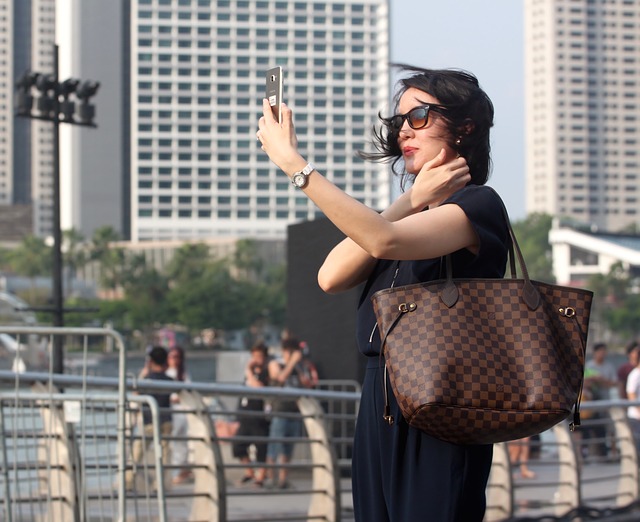Selfie-Esteem: The Relationship Between Body Dissatisfaction and Social Media in Adolescent and Young Women
Social media platforms like Instagram and Facebook have become ingrained in the lives of countless individuals. With adolescents and young adults, particularly young women, being the primary users of such platforms, it is an important question whether social media use has an impact on self-concept, self-esteem, body image, and body dissatisfaction. Researchers have started to empirically investigate these questions, and recent studies show mixed results. The present article attempts to review these findings and offers possible explanations for effects of social media use on body dissatisfaction, with a focus on Instagram, Facebook, and other popular image-based platforms.
“Social media is not real life,” stated Essena O’Neill, a 19-year-old Australian Internet star who quit social media in November of 2015 to prove the point that social media is just a means of fake self-promotion. Essena was a star on Instagram, Tumblr, YouTube, and other social media platforms, with over 600,000 followers on Instagram alone (McCluskey, 2016). As soon as she went silent, her fans and friends created an uproar. They called the Australian teen out and accused her of intentionally closing her social media accounts in an attempt to attract more fame and attention. Her fans, friends, and followers began posting blogs and videos in reaction to Essena quitting social media, with some going so far as sending death threats.
The same week Essena quit Instagram, The Guardian’s Mahita Gajanan (2015) asked other young women about their self-esteem and experiences with social media. Her findings were in line with Essena’s; most of the women that were interviewed felt insecure. Many young women reported obsessing over the number of “likes” they were getting, feared not looking beautiful in their photos, thought individuals would think they looked different on social media than in real life, and questioned what aspects of their life people would get a glimpse of. It was a common theme that women were dedicating extensive amounts of time to thinking about what image to upload, photoshopping it and regularly checking their personal page to see the updated “like” counts, which in turn increased their own insecurities. Even though many women were aware of these actions, they were consumed by their need to fit in on social media and struggled to disrupt their habits. Numerous young women reported that they lived their lives via social media and regarded media presence as more important than real life. This preoccupation with social media and the compulsive behaviors that follow may potentially contribute to body dissatisfaction. However, to this day, research findings have been mixed, and the exact relationship between social media behavior and body dissatisfaction is unclear.
The Influence of Media
Social media usage in particular has increased dramatically over the last decade and continues at an incline. Pew Research Center indicates that 71% of 13- to 17-year-olds use Facebook, 52% use Instagram, and 41% use Snapchat in 2015. Teenage girls are also using image-based social media platforms more frequently than their male counterparts; 61% of girls use Instagram versus 44% of boys. This increase in usage of social media, especially Facebook and Instagram, may negatively affect adolescent girls and young women in regard to their self-confidence and body satisfaction (Lenhart, 2015).
Some researchers have portrayed links between body dissatisfaction and eating disorders with exposure to fashion magazines or television shows in women (Grabe et al., 2008; Levine & Murnen, 2009). These studies examined exposure to media forms and body image to show that there may be a link between viewing images of thin bodies and personal body dissatisfaction. Another study by Becker and colleagues (2011) suggests that media effects can even take place indirectly. The authors studied whether direct and indirect exposure to mass media (i.e., television, videos, CD players, MP3 players, internet access, mobile phone access) were associated with eating pathology in Fijian adolescent girls. They found relationships between both direct mass media exposure (i.e., personal media exposure) and indirect mass media exposure (i.e., media exposure to the people in one’s peer group) with eating pathology in Fijian adolescent girls. Despite its limitations, such as the question of whether the findings can be generalized (Becker et al, 2011), the study suggests that at least in this case,social networks played an important role in the relationship between media and eating pathology, which may extend to a relationship between media and body dissatisfaction.
However, these findings must be taken with knowledge that some other researchers have found no link between viewing image based media and body dissatisfaction. Holmstrom (2004) conducted a meta-analysis on the pre-existing literature focusing on general media exposure and body dissatisfaction, body image and eating disorder pathology. Holmstrom focused on 34 studies that used media as the independent variable and a form of body image dissatisfaction as the dependent variable and the overall effect size was small. Surprisingly, the research showed that women reported feeling better about their bodies after viewing overweight images and had no change in body image after viewing thin bodies. These findings blur the potential relationship between body image and media and suggest a need to further investigate.
A more recent meta-analysis conducted by Ferguson (2013) extended the work of Holmstrom (2004), Grabe and colleagues (2008) and other researchers, and incorporated findings from 204 studies. A major point that Ferguson honed in on was publication bias; more specifically, that statistically significant results are more likely to be published and null findings are not, with meta-analyses being a collection of biased findings. Ferguson (2013) found little to no relationship between media and body dissatisfaction in males, however, there was a higher, but very small, prevalence in females, especially for those with a predisposition for body image issues. Overall, the meta-analysis encouraged researchers to be more conservative in their assertions of a relationship between social media and body dissatisfaction due to inflated effect sizes, study design limitations, and publication bias.
Social Media Usage
Social media offers a collaborative space for social interaction between seemingly infinite numbers of people. Several benefits have been identified in relation to the routine use of social media platforms. “The six key overarching benefits were identified as (1) increased interactions with others, (2) more available, shared, and tailored information, (3) increased accessibility and widening access to health information, (4) peer, social, emotional support, (5) public health surveillance, and (6) potential to influence health policy” (Moorhead et al., 2013, p. 8). Although there are several benefits associated with the use of social media, specifically image based social media, some uses of these platforms may lead to potentially unwanted effects. The primary image based social media platforms this review examines are Pinterest, Instagram and Facebook.
Lewallen and Behm-Morawitz (2016) suggest that adolescent girls and young women following fitness boards on Pinterest were more likely to report intentions to engage in extreme weight-loss behaviors, such as crash dieting or a radical exercise plan. In response to images viewed on the fitness boards on Pinterest, these adolescent girls and young women initiated a process of self-reflection, which increased intention to engage in extreme weight-loss behaviors. Overall, the results of this study revealed that social media environments might influence adolescent girls and young women to engage in social comparison leading to feelings of inadequacy and body dissatisfaction (Alperstein, 2015). Furthermore, based on the results of this study and others, negative body image concerns appear to be higher for those who internalized negative messages and images (Alperstein, 2015; Bell, 2016).
Currently, studies link social media platforms with body dissatisfaction in adolescent girls (Tiggemann & Miller, 2010; Tiggemann & Slater, 2013). In order to investigate the underlying processes, one study investigated over 100 seventh graders and found that adolescent girls who shared more photos online, such as selfies, and used more photoshop felt worse about their appearance and exhibited greater eating concerns (McLean et al., 2015). Specifically, some studies suggest greater usage of social media heighten body dissatisfaction due to an increase in appearance-related comments from friends (de Vries et al., 2015).
Using applications and other editing devices, such as Photoshop, to alter selfies is nothing new for many teens and women. Thanks to an array of free applications, people can alter the way their bodies look in photos with a swipe or a click. Teens can cover up blemishes, alter their facial shape, and manipulate their bodies to look thinner and more attractive (e.g., making their waists smaller or their breasts bigger). Even the popular socialites Kim and Khloe Kardashian have utilized Photoshop to post edited selfies for their Instagram accounts. As pointed out in an article by Mirror Magazine, many fans have criticized the sisters for unrealistic alterations to make themselves look thinner and more toned (Rutter & Strang, 2016).
Instagram and Body Dissatisfaction
Instagram is one of the most popular social media platforms (Kharpal, 2015). It allows users to communicate solely through posting and sharing photos. Researchers have looked at the role of Instagram on body image with adolescent girls and young women, the most frequent users of the social media platform. Anecdotally, in an interview with Elle Magazine, Emily Bryngelson, an associate designer at Ann Taylor, who admitted to struggling with an eating disorder as a teenager, revealed that she deletes selfies if she doesn’t receive enough “likes” (Fleming, 2014). She explains, “Instagram makes me so anxious. I’m always looking at other women thinking, ‘I wish I looked like that,’ or ‘I should get more in shape.’…I mean, young girls can now follow Victoria’s Secret models and see what they look like in the ‘every day.’ …That has got to make any woman, let alone a 13-year-old girl, feel unsure of herself.”
Studies on Instagram have mostly focused on fitspiration pictures and content in the young adult population. Fitspiration is a movement that promotes a healthy lifestyle, primarily through food and exercise. Despite its good intentions, researchers have suggested dysfunctional themes in the images and messages. For instance, when over 600 fitspiration images were studied, one major theme regarding the female body emerged: thin and toned (Tiggemann & Zaccardo, 2016). In addition, most images were found to contain elements objectifying the female body. However, we must wonder whether the blogs themselves are problematic or if the viewers are construing the content in a negative way. In other words, are certain individuals viewing a toned or thin body, comparing themselves to it, and then feeling bad about their own body?
Furthermore, some researchers suggest that even the mere act of watching fitspiration on Instagram can lead to unhealthy eating and exercise behaviors in young adults (Holland & Tiggemann, 2016). In one experiment where 130 female undergraduates were randomly exposed to either fitspiration or neutral travel images, scientists found that the appearance-based pictures of fitspiration had a negative impact on mood, body image, and self-esteem (Tiggemann & Zaccardo, 2015). In other words, the college students who viewed fitspiration images felt worse about themselves and their bodies compared to the students who viewed neutral images. Limitations of these studies need to be kept in mind when interpreting the findings. Using travel photos as a control to fitspiration may not have isolated the variable of interest and resulted in inaccurate findings. We expect humans to socially compare themselves to other humans more than they do with landscape. Future studies should consider incorporating control photos featuring attractive, but average-sized women, for example, to produce more comparable results.
Facebook and Body Dissatisfaction
Alongside Pinterest and Instagram, Facebook is common among adolescent girls and is associated with body dissatisfaction (Kimbrough et al., 2013; Tiggemann & Slater, 2013; Fardouly, Diedrichs, Vartanian, & Halliwell, 2015; Fardouly & Vartanian, 2015). For example, Tiggeman and Slater (2013) found that teenage girls who used Facebook were more concerned with monitoring body appearance, idealizing thinness, and pursuing thinness, than were teenage girls who did not use Facebook. Furthermore, in comparison to viewing an appearance-neutral website (i.e., a home craft website), viewing Facebook was associated with more negative mood and body dissatisfaction for women who tend to compare their appearance with others (Fardouly et al., 2015). However, rather than the time spent on Facebook, the way people use it, such as interacting with photos, seems to explain the relationship with body dissatisfaction (Meier & Gray, 2014; Fardouly & Vartanian, 2015; Kim & Chock, 2015). Meier and Gray (2014), for example, found that time spent on photo activity, rather than time spent on Facebook generally, was linked to thin-idealization, self-objectification, weight dissatisfaction, and pursuit of thinness.
Similarly, Kim and Chock (2015) found that “social grooming” behaviors such as “liking”, visiting, and commenting on friends’ posts and photos were linked to body image concerns. The researchers explained this link through the notion that “social grooming” activities lead to viewing other individuals’ profiles, particularly their photos. People tend to post attractive images of themselves on social media platforms (Manago et al., 2008), and increased exposure to these images may lead to a distorted and idealized conceptualization of body shapes. In October 2016, model and actress Gisele Bundchen posted a photo of herself on Facebook and within three weeks received 105,000 likes, 1,125 shares, and 1,437 comments such as “I want that bronzed skin!” and “Can I use it as a profile picture?” This type of social comparison has the potential to lead to poor body image, especially for adolescent girls and young women (Fardouly & Vartanian, 2015).
In Summary
The popularity of media, particularly social media, in youth makes it a potentially influential force. The findings discussed above provide a foundation for future research and have opened up important discussions on how social media use may influence body dissatisfaction. However, many studies are correlational, and the causal mechanisms behind the potential relationships are still unknown. Much of the findings may be applicable to an individual and not generalizable to the general public. Much work is needed in the future to parse apart potential factors for causation such as peer pressure and photo editing capabilities. Scientists have identified specific areas to focus on, such as the need to clarify the construct being measured (i.e., whether the outcome is eating disorder pathology, body dissatisfaction, and so forth) and to design the overall experiment by addressing the limitations of past research (Holmstrom, 2004; Ferguson, 2013). All in all, despite the mixed findings and limitations of past studies, past research seems to suggest a relationship between social media and body dissatisfaction, although the exact nature and strength of the relationship remains unknown.
References
Alperstein, N. (2015). Social comparison of idealized female images and the curation of self on Pinterest. The Journal of Social Media in Society, 4, 5-27.
Becker, A. E., Fay, K. E., Agnew-Blais, J., Khan, A. N., Striegel-Moore, R. H., & Gilman, S. E. (2011). Social network media exposure and adolescent eating pathology in Fiji. The British Journal of Psychiatry, 198, 43-50.
Bell, K. (2016). Social media and female body image. In BSU Honors Theses and Projects. Item 173. Retrieved from: http://vc.bridgew.edu/honors_proj/173
de Vries, D. A., Peter, J., de Graaf, H., & Nikken, P. (2016). Adolescents’ social network site use, peer appearance-related feedback, and body dissatisfaction: Testing a mediation model. Journal of Youth and Adolescence, 45, 211-224.
Fardouly, J., Diedrichs, P. C., Vartanian, L. R., & Halliwell, E. (2015). Social comparisons on social media: The impact of Facebook on young women's body image concerns and mood. Body Image, 13, 38-45.
Fardouly, J., & Vartanian, L. R. (2015). Negative comparisons about one's appearance mediate the relationship between Facebook usage and body image concerns. Body Image, 12, 82-88.
Ferguson, C. J. (2013). In the eye of the beholder: Thin-ideal media affects some, but not most, viewers in a meta- analytic review of body dissatisfaction in women and men. Psychology Of Popular Media Culture, 2, 20-37.
Gajanan, M. (2015). Young women on Instagram and self-esteem: 'I absolutely feel insecure.'
Retrieved November 10, 2016, from https://www.theguardian.com/media/2015/nov/04/instagram-young-women-self...
Grabe, S., Ward, L. M., & Hyde, J. S. (2008). The role of the media in body image concerns among women: A meta-analysis of experimental and correlational studies. Psychological Bulletin, 134, 460-476.
Holland, G., & Tiggemann, M. (2016). “Strong beats skinny every time”: Disordered eating and compulsive exercise in women who post fitspiration on Instagram. International Journal of Eating Disorders, 50, 76-79.
Holmstrom, A. J. (2004). The effects of the media on body image: A meta-analysis. Journal of Broadcasting & Electronic Media, 48, 196-217.
Essena O’Neill: Why I REALLY am quitting social media (Original Video). [Video File].
Retrieved from https://www.youtube.com/watch?v=Xe1Qyks8QEM
Kharpal, A. (2015). Facebook’s Instagram hits 400M users, beats twitter. CNBC. Retrieved from https://www.cnbc.com/2015/09/23/instagram-hits-400-million-users-beating...
Kim, J. W., & Chock, T. M. (2015). Body image 2.0: Associations between social grooming on Facebook and body image concerns. Computers in Human Behavior, 48, 331-339.
Kimbrough, A. M., Guadagno, R. E., Muscanell, N. L., & Dill, J. (2013). Gender differences in mediated communication: Women connect more than do men. Computers in Human Behavior, 29, 896–900.
Lenhart, A. (2015, April 9). Teens, social Media & technology overview 2015. Retrieved from http://www.pewinternet.org/2015/04/09/teens-social-media-technology-2015/
Levine, M. P., & Murnen, S. K. (2009). “Everybody knows that mass media are/are not [pickone] a cause of eating disorders”: A critical review of evidence for a causal link between media, negative body image, and disordered eating in females. Journal of Social and Clinical Psychology, 28, 9-42.
Lewallen, J., & Behm-Morawitz, E. (2016). Pinterest or thinterest?: Social comparison and body image on social media. Social Media+ Society, 2, 1-9.
Madden, M., Lenhart, A., Duggan, M., Cortesi, S., & Gasser, U. (2013). Teens and technology 2013. Washington, DC: Pew Internet & American Life Project.
Manago, A. M., Graham, M. B., Greenfield, P. M., & Salimkhan, G. (2008). Self-presentation and gender on MySpace. Journal of Applied Developmental Psychology, 29, 446–458.
McCluskey, M. (2016, January 5). Instagram star Essena O’Neill breaks her silence on quitting social media. Times. Retrieved from http://time.com/4167856/essena-oneill-breaks-silence-on-quitting-social-...
McLean, S. A., Paxton, S. J., Wertheim, E. H., & Masters, J. (2015). Photoshopping the selfie: Self photo editing and photo investment are associated with body dissatisfaction in adolescent girls. International Journal of Eating Disorders, 48, 1132-1140.
Moorhead, S. A., Hazlett, D. E., Harrison, L., Carroll, J. K., Irwin, A., & Hoving, C. (2013). A new dimension of health care: systematic review of the uses, benefits, and limitations of social media for health communication. Journal of medical Internet research, 15(4).
Meier, E. P., & Gray, J. (2014). Facebook photo activity associated with body image disturbance in adolescent girls. Cyberpsychology, Behavior and Social Networking, 17, 199-206.
Tiggemann, M., & Miller, J. (2010). The Internet and adolescent girls’ weight satisfaction and drive for thinness. Sex roles, 63, 79-90.
Tiggemann, M., & Slater, A. (2013). NetGirls: The Internet, Facebook, and body image concern in adolescent girls. International Journal of Eating Disorders, 46, 630-633.
Tiggemann, M., & Zaccardo, M. (2015). “Exercise to be fit, not skinny”: The effect of fitspiration imagery on women’s body image. Body Image, 15, 61-67.
Tiggemann, M., & Zaccardo, M. (2016). ‘Strong is the new skinny’: A content analysis of #fitspiration images on Instagram. Journal of Health Psychology.
Tiidenberg, K., & Cruz, E. G. (2015). Selfies, image and the re-making of the body. Body & Society, 21, 77-102.






